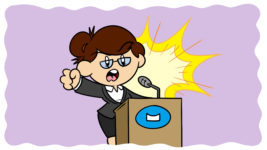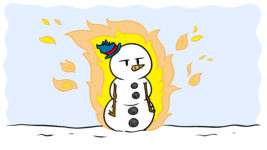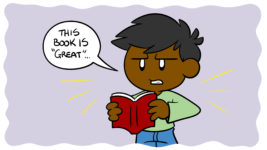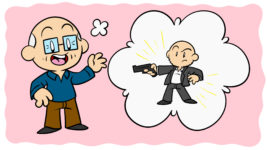Satire, pastiche, homage, and parody – four literary terms subject to frequent misuse. Most readers and writers have some sense of what each word means, but many struggle to pin down the specifics – something about real-world references, humor, and mockery, right? Well, kind of. These four horsemen may describe similar genre conventions and devices, but don’t be fooled: they’re not synonymous.
Instead, each term describes a convention, device, or phenomenon wholly distinct from the others. Now, maybe you already know whether Don Quixote is a parody or an homage, and maybe you can explain the relationship between irony and satire – if so, great stuff. This post isn’t for you, friend.
If, however, you’re unsure whether Scary Movie is parodic or satirical, or whether you pay homage to a writer by ruthlessly mocking or earnestly praising their work, read on!
Parody
Parody is, to be a little harsh, the crude younger sibling of the imitative and referential literary family. It’s not seeking to honor anything, it’s not trying to criticize, it tends not to have anything smart or cutting to say about art or society (though there are exceptions.) Instead, it’s all about pointing, mocking, and laughing. Most parody nowadays is cinematic (if cringe-fests like The Starving Games and Fifty Shades of Black can be called cinematic), but books exist too: Seth Grahame-Smith’s Pride and Prejudice and Zombies, for example, or the wildly popular Ladybirds for Grown-Ups series that has been sweeping the UK for the past few years.
Parody works through straightforward imitation of a particular work, author/artist, or style, and relies on comic exaggeration, caricature, and juxtaposition to expose, for example, trite genre conventions, distinct stylistic choices, ridiculous characters, and, at its most stupid, funny accents. Bad parody tends to be eye-wateringly painful, but the good stuff – I’m thinking, for example, of the aforementioned Don Quixote, most Mel Brooks films, and John Reed’s Snowball’s Chance – manages to be joyous, celebratory, and hilarious, as well as intelligent.
Good parody isn’t content to merely copy; instead, it presents original content in the exaggerated style of an existing text. Pride and Prejudice and Zombies works because it’s written in the style of a Jane Austen novel, not because it stars Mr. Darcy or takes place in a posh English manor, and Futurama succeeds in mocking The Twilight Zone so completely because its parody counterpart, The Scary Door, mimics the style, form, and logic of The Twilight Zone rather than the content itself. Bad parody, conversely, apes the setting, plot, and characters of an existing text but pays no attention to the original text’s style, tone, form, or intention.
Pastiche
Next up, we have pastiche. Like parody, pastiche tends to be imitative rather than referential; that is, it tends to be rather explicitly and wholly a response to an existing text rather than a standalone work able to operate without context.
The main difference between pastiche and parody is that, where parody seeks to mock and ridicule, pastiche is more loving in its approach; while it tends to be light-hearted, pastiche nonetheless seeks to honor and celebrate its target text/author/style. Literary examples of pastiche include David Markson’s Wittgenstein’s Mistress, Tom Stoppard’s Rosencrantz and Guildenstern Are Dead, and John Banville’s Mrs. Osmond, which emulate, continue, and celebrate the works of Samuel Beckett and Ludwig Wittgenstein, William Shakespeare, and Henry James respectively.
Pastiche can also refer to a postmodern phenomenon by which old styles are endlessly resurrected, sewn together, and cycled through in modern fiction. For example, a modern novel may contain elements of realism, absurdism, romanticism, modernism, naturalism, and expressionism without belonging to any one of those literary movements; instead, the novel is a pastiche, or collage, of old, dead styles and voices.
Homage
Works of homage tend to be less directly imitative of their target works and more abstractly or tangentially related. The word is far broader in its meaning than either ‘parody’ or ‘pastiche’ – an homage might be limited to a particular paragraph or reference in a larger work, or even to a footnote or dedication, and needn’t affect the broader form and content of the text itself.
Homage goes one step further than pastiche in that its referential approach is somber as well as celebratory; it honors the text/style/artist it references in an often serious, straight-faced manner, without necessarily imitating or even explicitly referencing it. In its simplest form, an homage could simply be a statement expressing an admiration for something – the sentence ‘At the end of the day, trees are the best things in the world – elms, sycamores, cypress, all of them life-giving and bright,’ is, technically, an homage to trees, but not all homages are this blunt.
Homage can be much more subtle – a director, for example, might try to imitate Stanley Kubrick’s distinctive scene composition in their own films, or a writer might show their respect for Virginia Woolf by using motifs strongly associated with her – a lighthouse, for example, or the shore of Skye – in their own literary work.
Poets often pay homage to other artists in opening dedications, titles, or even content; John Ashbery’s ‘Girls on the Run,’ which pays homage to the artist Henry Darger, opens with ‘After Henry Darger,’ while Philip Levine’s poem ‘On the Meeting of Garcia Lorca and Hart Crane’ features both Federico Garcia Lorca and Hart Crane as characters.
Homage, then, is a broad, vague term that encompasses all manner of straight-faced tributes to past writers, works, objects, and concepts. It’s hard to go wrong here, so worry not!
Satire
Ah, satire. Beloved by smug cynics and armchair academics the world over, works of satire are, unlike works of pastiche, parody, and homage, purposeful; they tend to be far more engaged in the real world and often pick various real-world powers and/or ideologies as the targets of their ire with the objective of spreading awareness or inciting some kind of change. Satire, essentially, is a form of social criticism.
Satirical works tend to be (ideally) sharp, cutting, funny, depressing, and thought-provoking. Because satire tends to target broader phenomenon than pastiche and parody (i.e. it comments on, for example, society or a particular ideology, not simply a particular text), it tends to be less imitative and referential and more inventive in its approach, form, and style.
There are dozens of famous literary satires to give you a better idea of what satire is and isn’t – Joseph Heller’s Catch-22, for example, or Mikhail Bulgakov’s The Master and Margarita, or George Orwell’s Animal Farm, or basically any of George Saunders’ short stories. Each of these texts targets a particular social or political phenomenon, and each utilizes humor, absurdity, tragedy, and allusion in their criticism.
Like ‘homage,’ ‘satire’ is a broad term for texts across the genre spectrum, meaning there’s no single definition; a satirical work might incorporate elements of parody and pastiche, or may rely purely on irony (verbal, situational, and dramatic), juxtaposition, exaggeration, allegory, absurdity, the burlesque, and/or analogy. Satires don’t need to be funny – indeed, Sinclair Lewis, Philip Roth, George Orwell, and Franz Kafka are hardly known for their comedic writing. Instead, rather than trying to make something funny, as parodists do, satirists instead seek to pointedly present social, political, and ideological phenomenon in new and exaggerated contexts so that they might be assessed, understood, and critiqued.
Fools are my theme, let satire be my song
Hopefully, you’re now able to pick your pastiches from your parodies and understand the levels of imitation and reference involved in, say, an homage versus a satire.
Understanding these terms can also open doors in your own writing, not least in allowing you to identify, research, and improve whichever of the above you’re writing. Plus, there’s a certain kind of reader who hates to see any of these terms misapplied. Most importantly, you’re now entitled to tut when someone misidentifies a parody or when someone tries to argue that Spaceballs is satirical.
What are your favorite works of parody, pastiche, homage, or satire? Have you experimented with these devices yourself? Let me know in the comments, and check out What Writers Like You Need To Know About Irony And Sarcasm and The 3 Types Of Humor Your Story Needs for more great advice on humorous writing.





